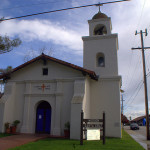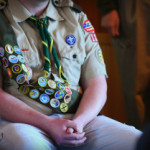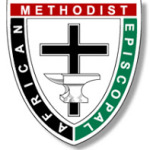Again, wanting to ensure we “got our money’s worth” Dr. Williams ran us ragged through Jerusalem and a few outlying areas. I would like to say parenthetically, that although most of these sites are the mostly likely places that these events occurred, and experiences there can be, and we moving, it struck me how we have covered over all these places that would be fitting memorial, a pillar of stones as was done in the Old Testament, with all the trappings of Christendom. I would have preferred to climb a dusty rocky hill to the place where Christ was crucified like Balian did in Kingdom of Heaven, than climb a narrow staircase in an Orthodox church filled with shiny icons, only to see a two-foot by four-foot piece of the hill under a glass case. In some cases, I would have rather stood on the rock than those marble floors, but perhaps that is my Protestant background showing through.
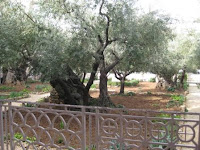 |
| The Garden of Gethsemane |
 |
| Paul at Gethsemane |
We began at Gethsemane, where this great olive orchard now contains about twelve of the most ancient olive trees in Israel in a small, walled off garden. Everything else has been paved over by the Church of the Nations, also called the Church of Agony. I learned that olive trees spout a branch, which lives its life, and then dies. Then the “dead” tree sprouts a new branch to begin the cycle again. This life, death, and life again, is a fitting symbol for Jesus.
 |
| The U.S.A.’s ceiling in the Church of Nations |
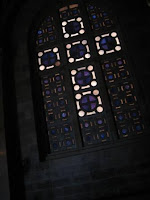 |
| Alabaster Window in the Church of Agony |
The windows of the church of Agony are made of alabaster, so it always has the look of night inside. It is also called the Church of Nations because various nations donated to make the ceiling, and placed their seals in the ceiling art. Pieces of bedrock come up through the floor in the front of the Church of Agony. Tradition tells us that the rock in front of the altar is where Jesus prayed and sweated blood. Interestingly, although all the all the classic paintings show Jesus praying on a rock, the Bible just says he fell on the ground praying. I did see an outcropping of rock in the corner that looked like a nice place to take a nap, and I told Shawn, “If I was a disciple, I probably would have fallen asleep there.”
 |
| Altar stone in the Church of Agony |
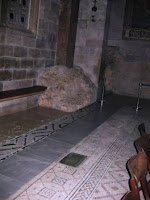 |
| Where I would have fallen asleep |
They went to a place called Gethsemane, and Jesus said to his disciples, “Sit here while I pray.” He took Peter, James and John along with him, and he began to be deeply distressed and troubled. “My soul is overwhelmed with sorrow to the point of death,” he said to them. “Stay here and keep watch.” Going a little farther, he fell to the ground and prayed that if possible the hour might pass from him. “Abba, Father,” he said, “everything is possible for you. Take this cup from me. Yet not what I will, but what you will.” Then he returned to his disciples and found them sleeping. (Mark 14:32-37)
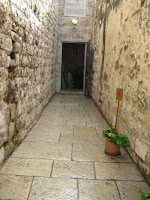 |
| Entrance to the Gethsemane Grotto |
Continuing at Gethsemane, we walked to the grotto. This is a cave where the olive press used to be. For an olive grove this size, as it was in the time of Jesus, only one press would be needed, so this is the spot. The Bible does not mention the disciples going to an olive press cave, but here is where we can add some reasoning to the biblical narrative. Jesus often took his disciples to the Mount of Olives; it was their retreat, so they likely knew about the press cave and had been in there before. So in Jesus’ day we are in an orchard, in a hilly area, a place with bedrock outcroppings, and a cave. Jesus is out there at night with his disciples, and they could be anywhere. It is no wonder the temple guard needed Judas to find Jesus.
 |
| Inside the grotto |
While he was still speaking, Judas, one of the Twelve, arrived. With him was large crowd armed with swords and clubs, sent from the chief priests and the elders of the people. Now the betrayer had arranged a signal with them: “The one I kiss is the man; arrest him.” Going at once to Jesus, Judas said, “Greetings, Rabbi!” and kissed him. (Matt 26:47-49). He could have eluded them all night, and the disciples had plenty of places to hide when they scattered. “Am I leading a rebellion,” said Jesus, “that you have come out with swords and clubs to capture me? Every day I was with you, teaching in the temple courts, and you did not arrest me. But the Scriptures must be fulfilled.” Then everyone deserted him and fled. A young man, wearing nothing but a linen garment, was following Jesus. When they seized him, he fled naked, leaving his garment behind. (Mark 14:48-52).
 |
| Jerusalem East Gate viewed from Gethsemane |

From Gethsemane, we could see the East Gate of Jerusalem. This is the gate of Jesus’ Triumphal Entry.
They threw their cloaks on the colt and put Jesus on it. As he went along, people spread their cloaks on the road. When he came near the place where the road goes down the Mount of Olives, the whole crowd of disciples began joyfully to praise God in loud voices for all the miracles they had seen: “Blessed is the king who comes in the name of the Lord!” “Peace in heaven and glory in the highest!” (Luke 19:35-38).
When the gate was rebuilt, it was built by a man who believed the Messiah had not yet come, and wanted to prevent his coming, so the gate was built closed and a cemetery was placed in front of it to make anyone entering that gate ceremonially unclean. Whoever touches the dead body of anyone will be unclean for seven days (Num. 19:11).
 |
| Group photo at the top of the Mt. of Olives |
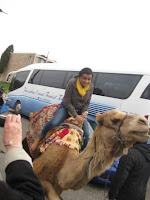 |
| Ana riding a camel |
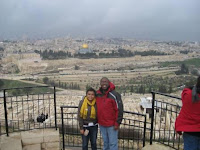 |
| Ana and Paul |
We proceeded up to the top of the Mount of Olives, where one can see all of Jerusalem, and Ana finally got her camel ride. This is where Jesus ascended. Jesus was taken up before their very eyes, and a cloud hid him from their sight. They were looking intently up into the sky as he was going, when suddenly two men dressed in white stood beside them. “Men of Galilee,” they said, “why do you stand here looking into the sky? This same Jesus, who has been taken from you into heaven, will come back in the same way you have seen him go into heaven.” Then they returned to Jerusalem from the hill called the Mount of Olives, a Sabbath day’s walk from the city (Acts 1:9-12).
 |
| Upper Room |
Before midday we entered the Old City of Jerusalem and headed to the Upper Room. In the quieter parts of the Old City one could think he was in Disneyland instead of an actually ancient city. Whether or not this Upper Room was the actual place or not, it is a good place of remembrance. We know that the early church met at the house of Mary the mother of John Mark. Peter went to the house of Mary the mother of John, also called Mark, where many people had gathered and were praying (Acts 12:12). It is likely that her home would have been a place they had used before, perhaps for the Last Supper, hiding during Jesus’ death and resurrection, and where they received the Holy Spirit. When the day of Pentecost came, they were all together in one place. Suddenly a sound like the blowing of a violent wind came from heaven and filled the whole house where they were sitting. They saw what seemed to be tongues of fire that separated and came to rest on each of them. All of them were filled with the Holy Spirit and began to speak in other languages as the Spirit enabled them (Acts 2:1-4).
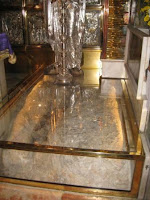 |
| Mount of Crucifixion |
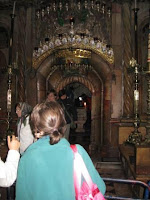 |
| The Tomb of Jesus |
After some shopping, losing Leanne, and finding Leanne, our group went to the Church of the Holy Sepulcher. I have already written about some of my experiences in this church in the opening paragraph. There is one church with an Orthodox side and Roman Catholic side. The Orthodox side has the mount of crucifixion under glass. This hilltop has a crack in it that was likely the result of an earthquake. When the centurion and those with him who were guarding Jesus saw the earthquake and all that had happened, they were terrified, and exclaimed, “Surely he was the Son of God!” (Matt. 27:54). In the middle section is the stone where Jesus’ body was laid before being placed into the tomb. There is also a ladder there that has become somewhat of a relic in its own right. Apparently some repair work needed/still needs to be done in the church, but the churches could not agree on who was responsible for the repairs, so the ladder just stood there. I imagine, if someone tried to move that ladder, there would be a riot. On the Catholic side is the tomb of Jesus, and Joseph of Arimathea’s burial place. I was surprised at the close proximity of the crucifixion and burial site, but it make sense with the biblical account, as they were in a rush to bury Jesus before the Sabbath, Joseph of Arimathea would offer his nearby tomb. Now there was a man named Joseph, a member of the Council, a good and upright man, who had not consented to their decision and action. He came from the Judean town of Arimathea and he was waiting for the kingdom of God. Going to Pilate, he asked for Jesus’ body. Then he took it down, wrapped it in linen cloth and placed it in a tomb cut in the rock, one in which no one had yet been laid. It was Preparation Day, and the Sabbath was about to begin. The women who had come with Jesus from Galilee followed Joseph and saw the tomb and how his body was laid in it. Then they went home and prepared spices and perfumes. But they rested on the Sabbath in obedience to the commandment. (Luke 23:50-56).
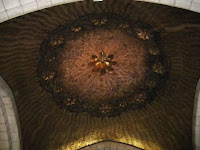 |
| Crown of Thorns Ceiling |
We then went to a few Stations of the Cross on the Via Delarosa. Although we would not stop at all the stations, viewing the stations would continue until the next day. We were moving pretty fast, and I was one of the herders, keeping the slower walkers and shoppers from getting too far behind, so I did not get many pictures. One place we did take some time was the place where the crown of thorns was placed on Jesus’ head. The ceiling had a crown of thorns on it, and it turns out that this is common at some of these stations. They put a purple robe on him, then twisted together a crown of thorns and set it on him (Mark 15:17).
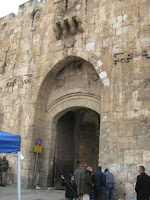 |
| Stephen’s Gate |
We left the Old City through Stephen’s Gate, also called the Lions Gate. This is one of the places where Stephen may have been stoned and died as a martyr. When they heard this [Stephen’s proclamation], they were furious and gnashed their teeth at him. But Stephen, full of the Holy Spirit, looked up to heaven and saw the glory of God, and Jesus standing at the right hand of God. “Look,” he said, “I see heaven open and the Son of Man standing at the right hand of God.” At this they covered their ears and, yelling at the top of their voices, they all rushed at him, dragged him out of the city and began to stone him. Meanwhile, the witnesses laid their clothes at the feet of a young man named Saul. While they were stoning him, Stephen prayed, “Lord Jesus, receive my spirit.” Then he fell on his knees and cried out, “Lord, do not hold this sin against them.” When he had said this, he fell asleep. (Acts 7:54-60).
 |
| Typical rich tomb |
The Sabbath evening was coming quickly, but we crammed in two more stops. First were the Sanhedrin’s Tombs. This was to give us a visual of what rich people’s tombs looked like, and Dr. Williams went over some of the burial rituals.
 |
| Sameul’s Burial Place |
 |
| Gibeon and Gilboa viewed from Ramah |
Our final stop of the day was Samuel’s burial place, Ramah. Now Samuel died, and all Israel assembled and mourned for him; and they buried him at his home in Ramah (1 Sam. 25:1). Ramah means “high place” so this is the place he is believed to have been buried. The building there has not been developed, but from this high place one can see Gilboa (the city of Saul) and the city of Gibeon (where the people fooled Joshua into making a peace treaty) However, when the people of Gibeon heard what Joshua had done to Jericho and Ai, they resorted to a ruse: They went as a delegation whose donkeys were loaded with worn-out sacks and old wineskins, cracked and mended. The men put worn and patched sandals on their feet and wore old clothes. All the bread of their food supply was dry and moldy. Then they went to Joshua in the camp at Gilgal and said to him and the men of Israel, “We have come from a distant country; make a treaty with us.” (Jos 9:3-6).
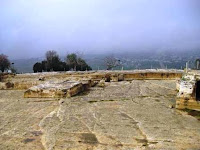 |
| Crusader Ruins |
This site also contains the ruins of a Crusader base of operations. Since it is on a high place, they could oversee Jerusalem.
©2011 Paul Tillman









 From Gethsemane, we could see the East Gate of Jerusalem. This is the gate of Jesus’ Triumphal Entry. They threw their cloaks on the colt and put Jesus on it. As he went along, people spread their cloaks on the road. When he came near the place where the road goes down the Mount of Olives, the whole crowd of disciples began joyfully to praise God in loud voices for all the miracles they had seen: “Blessed is the king who comes in the name of the Lord!” “Peace in heaven and glory in the highest!” (Luke 19:35-38).
From Gethsemane, we could see the East Gate of Jerusalem. This is the gate of Jesus’ Triumphal Entry. They threw their cloaks on the colt and put Jesus on it. As he went along, people spread their cloaks on the road. When he came near the place where the road goes down the Mount of Olives, the whole crowd of disciples began joyfully to praise God in loud voices for all the miracles they had seen: “Blessed is the king who comes in the name of the Lord!” “Peace in heaven and glory in the highest!” (Luke 19:35-38).












